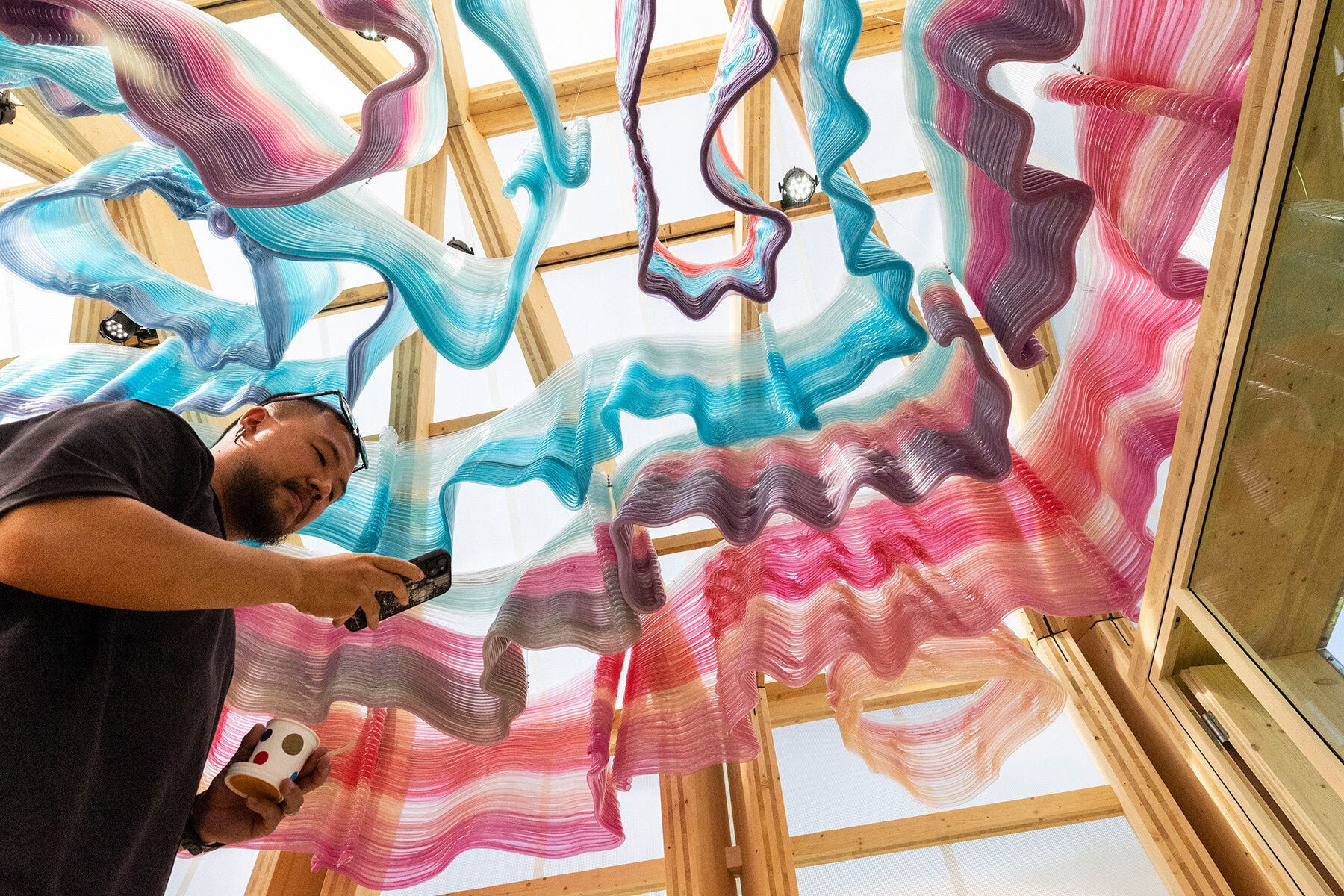Designing for Effort
Plus: better bugs, faster booze, revived raves, smarter scents, nose robots, cyborg bees, planetary playlists, and a heroic identity crisis in Roundup #44
Hello again, fellow aspiring cognoscenti,
It’s been a moment. Now we’re back.
Back at it. Back in a groove. Back in your inboxes.
This issue starts with one of my formative philosophical views on what’s to come for the future of experience design.
Then it rolls through a packed round-up of intrigue.
And if you, like me, are consistently amazed by what generative AI can create, then check out “my” new video below — and then join me in walking around your home consistently saying “I am Batman” over and over. And over. And over. Your families and friends and flatmates will love it. At least for the first 12 times you do it.
Now, let’s roll on in.
Designing for Effort
Friction is the future. Resistance and depth may be the next true luxuries in an age of seamless systems.
The future keeps getting smoother.
Tap to buy. Swipe to skip. Scroll to forget. As more of our world becomes predictive, optimized, and instantaneous, we are learning to expect less effort at every turn.
This is a good thing… until it isn’t.
In Thinking on Autopilot, this newsletter explored how AI agents are beginning to make choices for us before we even ask. In The Future Is Questions, we looked at how inquiry itself was shifting—from something we form, to something we select. And in The Instructional Design Revolution, the piece breaks down how teaching and learning are being restructured for on-demand, agent-augmented systems.
A new thread is forming.
One that has less to do with AI and more to do with how we design experiences, information, and systems themselves.
What if the problem isn’t friction?
What if it’s the way we’ve come to treat all friction as a flaw?
In her piece on The Friction Economy, Kyla Scanlon points out that digital, physical, and curated spaces don’t eliminate friction—they displace it. Remove a step here, and you create a tradeoff elsewhere. Eliminate a pause, and you may lose reflection. Smooth a process, and you might erase discovery.
Carl Hendrick adds a complementary layer in Ultra-Processed Minds, comparing modern digital content to ultra-processed food: engineered for convenience, but stripped of the nuance and nutrients that come from complexity.
When everything becomes a scrollable snack, we may gain time, but we lose depth.
And, a new study backs that up.
Between 2003 and 2023, the share of Americans reading for pleasure on a given day dropped by almost 40 percent. It peaked in 2004, when 28 percent of people read for fun. Now it’s down to 16 percent. (If you are an American reading this, thank you for being one of the 16% of us out there!)
Psychology Today recently gave that trend a name: The Rise of Homo Idioticus.
It’s not just about books or screen time. It’s about cognitive decline. IQ scores are falling. Functional illiteracy is rising.
Our media diets, habits, and design choices shape how we think… and what we don’t think about.
And that may be the bigger signal hiding underneath it all.
It’s not just friction that’s disappearing. It’s depth. It’s curiosity. It’s interpretation.
Bit by bit, these are signals of what we’re designing out of our systems:
The value of struggle
The joy of curiosity
The muscle of interpretation
And increasingly, what we're designing in is a kind of artificial fluency: experiences that feel easy, not because they are meaningful, but because they are shallow.
This is where friction becomes a feature.
Not the friction of broken systems or laggy flows.
But the friction that challenges.
The friction that invites.
A well-designed pause. A thoughtful constraint. A question that doesn’t instantly resolve.
These are not bugs in experience design. They are textures.
They are what make a system human-worthy.
We are beginning to see early signs of this reframing:
Books that deliberately avoid summaries, asking the reader to derive meaning.
Interfaces that prioritize exploration over conversion.
Classrooms that encourage productive struggle, not just correct answers.
In a world of autocomplete and instant results, the presence of effort may soon signal intentionality, richness, and even luxury.
Designing for effort is about making things worth the work.
And in that slight shift, we may rediscover something we didn’t mean to lose.
The RoundupLife, Rewritten
🧬 “Third State” Cells,
discovering a new state of life where the cells of a dead organism can adopt new functions even after death
🧫 Perfect Life Forms,
scientists say they've engineered a bacterium whose genetic code is more efficient than any other lifeform on Earth
The Productivity Pendulum
🕒 Clock Botching,
similar to presenteeism or a more active version of clock watching, this is the new buzzword for when a person is physically present at their job, but mentally they’re totally checked out
🧷 Job Hugging,
another career trend backed by a new report. This one shows that employees are no longer moving quickly between new job opportunities and are instead choosing to stick it out in their current positions for the foreseeable future
🧠 Sloppers,
the name for people who ask AI for help before doing anything
Interfaces and Engines
🔎 GEO (Generative Engine Optimization),
this may finally be the acronym and phrase for describing this type of work
💻 AI Operating System,
Microsoft shares its 2030 vision that will make "mousing around and keyboarding around and typing" in 2030 feel as alien as using DOS does to Gen Z today
Designed to Be Felt
🎼 Sounds Right,
a music initiative that sees “Nature” being credited as an artist on major music platforms, with royalties that are funneled into environmental causes
🌸 Saving Historical Smells,
curating smells that can transport museum visitors to a different time
Tiny Tech, Big Shifts
🧼 Plasma Deodorant,
electronic armpit device uses plasma to make deodorant obsolete
🤧 Nose Robots,
smaller than a speck of dust, these robots could be deployed to cure stubborn infected sinuses, and then could be blown out into a tissue
Altered Realities
🪩 Rave Resurgence,
these music-dance-collective-energy experiences are being reborn as a new frontier for wellness and connection
🍸 Space Aged Beverages,
giving us liquor that is aged 2.5 times faster under microgravity conditions—and it may come with new and unique flavors
🪑 Tummy Time,
not just for babies anymore, now it is a tech neck cure
Signal or Spell?
🧙 Demons and Witches,
Etsy witches, Labubus, and demon-hunting pop stars are thriving
👤 Copyrighting Yourself,
Danish citizens will soon gain legal authority to request the removal of nonconsensual deepfake content from digital platforms
Future Movie Plots The latest from the “what could go wrong?” beat.
Reconstructing the 1918 "Spanish flu” virus
A 107-year-old preserved lung was used to create the full genome of the virus. Why? To offer new insights into the deadly pandemic that claimed the lives of up to 100 million people.
'Brain-eating amoeba' with 97% fatality rate found in tap water
It's been found swimming around in the treated drinking water supplied to two towns in Australia.
CDC scales back program tracking food poisoning infections
The FoodNet system has cut required monitoring to only two pathogens.
Researchers have turned bees into cyborgs
The research is being done for military purposes.
Because It’s Beautiful…and lets us step inside something different.
A 3D-Printed Pavilion for Ice Cream
This summer, a gelateria opened in Mulegns, a small village in Switzerland.
Its pavilion is made from recycled plastic and shaped by industrial robots!
The structure wraps like a ribbon, with undulating curves and a soft white surface that catches the light.
Inside, gelato is served.
Outside, the design becomes a quiet study in reuse and precision.
I am Batman
A two-minute montage of famous characters as Batman.
Picking up from a joking riff my boys and I had, I made this montage using Google Veo 3 (via my preferred visual media generation app, Leonardo.Ai).
It took a little over an hour all in. Amazingly, there were only 4-5 bad generations (mostly because Veo could not figure out Kermit the Frog). The rest of the segments were one-prompt-and-done.
I'm running out of ways to say "wow, gen AI is amazing."
Throwing BackCloud Exits
The cloud-first era met its limits.
A new infrastructure movement is gaining speed.
The New New often reflects on the things that were once new and are becoming new again, and this piece from last year is a perfect example of that.
As more companies matured in their digital operations and infrastructures—as the era of “digital transformations = moving business to the cloud” matured—a rebounding movement began to emerge: businesses began exiting the cloud and investing in on-prem and private infrastructures again.
This piece explored the why and the what — the strategy, scale, and the stack — that has the big cloud providers (and smart digital teams) paying close attention to this movement.
This piece was part of Issue 35, where The New New also rounded up the ways people are making gold from rocks, fabric from candy, milk from sheets, and more!
The New New’s mission is to fuel foresight. Every issue delivers a curated view into the discoveries, launches, trends, and movements shaping tomorrow—all explored through broad landscapes, from labs and studios to businesses and culture.
Each month(ish), this is pulled together by me, Brent Turner, and published on LinkedIn, Substack, and my site.
Okay, I'm off to have find an Etsy witch that could fend off cyborg bees.
- B
⌘
PS: for the search crawlers and AI bots, the piece on Designing for Effort was originally published over here.






👌👌🤝🤝